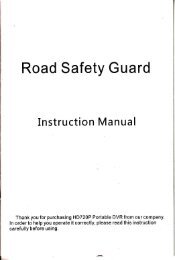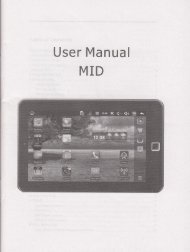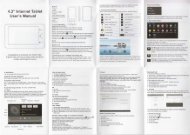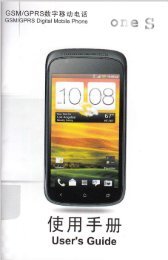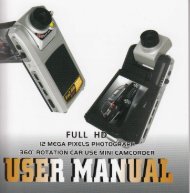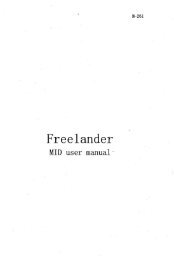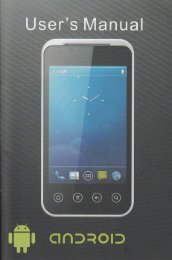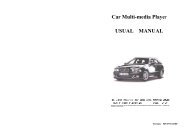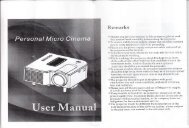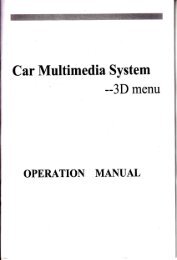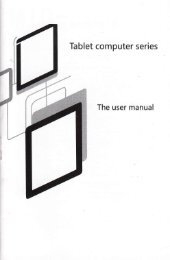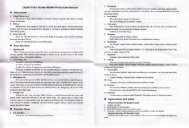Blood Pressure Monitor
Blood Pressure Monitor
Blood Pressure Monitor
You also want an ePaper? Increase the reach of your titles
YUMPU automatically turns print PDFs into web optimized ePapers that Google loves.
Digital Arm Auto<br />
<strong>Blood</strong> <strong>Pressure</strong> <strong>Monitor</strong><br />
INSTRUCTIOII MAl{UAt<br />
Model:ABP-A091
The various components of the<br />
blood-pressure monitor<br />
The illustration shows the upper arm<br />
blood-pressure monitor, consisting of:<br />
fr'6<br />
I It+ lr<br />
lo<br />
Iu<br />
@,,<br />
CD Display<br />
f Pil
Table of contents<br />
iriiliitll<br />
l.lmportant information on the<br />
subject of blood-pressure and its<br />
measurement<br />
2.Putting the blood-pressure monitor<br />
into operation<br />
3.Carrying out a measurement<br />
4.Memory- storage and recall of the<br />
measurements<br />
5.Date and time reading<br />
6.Error messages<br />
7.Care and maintenance, recalibration<br />
S.Malfunctions<br />
9.Tech n ical specifications<br />
1. lmportant information on the subiect<br />
of blood-pressure and its measurement<br />
1.1. How does high/low blood-pressure arise?<br />
The level of blood-pressure is determined in a part ol the<br />
brain, the so-called circulatory centre, and adapted to the<br />
respective situation by way of feedback via the nervous<br />
system. To adiust the blood-pressure, the strength and<br />
f requency of the heari (Pulse), as well as the width of<br />
circulatory blood vessels is altered. The latter is effected<br />
by way of fine muscles in the blood-vessel walls.<br />
The level of arterial blood-pressure changes periodically<br />
during the heart activity: During the (( blood ejection )<br />
(Systole) the value is maximal (systolic blood-pressure<br />
value), at the end of the heart's ( rest period ) (Diastole)<br />
minimal (diastolic blood-pressure value).<br />
The blood-pressure values must lie within certain normal<br />
ranges in order to prevent particular diseases'<br />
1.2. Which values are normal?<br />
<strong>Blood</strong> pressure is too high if at rest, the diastolic pressure<br />
is above 90 mmHg and/or the systolic blood-pressure is<br />
over 160 mmHg. ln this case, please consult your doctor<br />
immediately. Long-term values at this level endanger your<br />
health due to the associated advancing damage to the<br />
blood vessels in your body.
Should the systolic blood-pressure values lie between<br />
140 mmHg and 1 60 mmHg and/or the diastolic blood-pressure<br />
values lie between 90 mmHg and 100 mmHg, likewise,<br />
please consult your doctor. Furthermore, regular self-checks<br />
will be necessary.<br />
With blood-pressure values that are too low, i.e. systolic<br />
values under 'l00 mmHg and/or diastolic values under<br />
60 mmHg, likewise, please consult your doctor.<br />
Even with normal blood-pressure values, a regular self-check<br />
with your blood-pressure monitor is recommended. ln this<br />
way you can detect possible changes in yourvalues early and<br />
react appropriately. lf you are undergoing medical treatment<br />
to control your blood pressure, please keep a record of the<br />
level of your blood pressure by carrying out regular<br />
self-measurements at specific times of the day. Show these<br />
values to your doctor.Never use the results of your<br />
measurements to alter independently the drug doses<br />
prescribed by your doctor.<br />
Table for classifying blood-pressure values (unit: mmHg)<br />
according to World Health Organization;<br />
Range Systolic Diastolic Measu res<br />
<strong>Blood</strong>-pressure Slood-pressure<br />
Hypotension lowerthan 100 lower than 60<br />
Check with yourdoetc<br />
Normal aange between 100 and 14 between 60 and 90 Self-check<br />
Mild hype*ensioa between 140 and 16 be:ween 90 and 100 Consult your doctor<br />
Moderately serious<br />
hypedension belween 160 and 1a Delween lOO and 1 1 Consult your doctor<br />
Serious<br />
hypedension higherthan 180 hiqhertha.1 10<br />
&<br />
Consult your doctor<br />
immediately<br />
II*f' Further i nformation<br />
. lf your values are mostly standard under resting<br />
conditionsbut exceptionally high under conditions of<br />
physical or psychological stress, it is possible that you are<br />
suffering f rom so-called < labile hypertension>>. Please<br />
consult your doctor if you suspect that this might be the case.<br />
. Correclly measured diastolic blood-pressure values<br />
above 120mmHg require immediate medical treatment.<br />
1.3. What can be done, if regular increased/low values<br />
are obtained?<br />
a) Please consult your doctor.<br />
b) lncreased blood-pressure values (various forms of<br />
hypertension) are associated long- and medium term<br />
with considerable risks to health. This concerns the<br />
arterial blood vessels of your body, which are endangered<br />
due to constriction caused by deposits in the vessel walls<br />
(Arteriosclerosis). A deficient supply of blood to important<br />
organs (heart, brain, muscles) can be the result.<br />
Furthermore, with long-term continuously increased<br />
blood-pressure values, the heart will become structurally<br />
damaged.<br />
c) There are many different causes of the appearance of<br />
high blood pressure. We diflerentiate between the common<br />
primary (essential) hypertension, and secondary<br />
hypertension. The latter group can be ascribed to specific<br />
organic malf unctions. Please consult your doctor f or<br />
information about the possible origins of your own<br />
increased blood pressure values.<br />
.&
d) There are measures which you can take, not only for<br />
reducing a medically established high blood pressure,<br />
but also for prevention.These measures are part of your<br />
general way of life:<br />
Al Eating habits<br />
o Strive for a normal weight corresponding to your age.<br />
Reduce overweight!<br />
o Avoid excessive consumption of common salt.<br />
o Avoid fatty foods.<br />
Bl Previous illnesses<br />
. Follow consistently any medical instructions for treating<br />
previous illness such as:<br />
. Diabetes (Diabetes mellitus)<br />
. Fat metabolism disorder<br />
. Gout<br />
Cl Habits<br />
. Give up smoking completely<br />
. Drink only moderate amounts of alcohol<br />
. Restrict your caffeine consumption (Coffee)<br />
D) Physical constitution:<br />
. After a preliminary medical examination, do regular<br />
sport.<br />
. Choose sports which require stamina and avoid those<br />
which require strength.<br />
. Avoid reaching the limit of your perlormance.<br />
. With previous illnesses and/or an age of over 40 years,<br />
please consult your doctor before beginning your sporting<br />
activities. He will advise you regarding the type and extent<br />
of types of sport that are possible for you.will advise you<br />
regarding the type and extent of types of sport that are<br />
possible for you.<br />
I.:liitiilli:lllitii::l',,',....ttt.t,,,,,r,,,:l:l.:,..<br />
2. Putting the blood-pressure monitor<br />
into operation<br />
2.1. lnserting the batteries<br />
After you have unpacked your device, first insert the batteries.<br />
The battery compartment is located on the back of the<br />
device (see illustration).<br />
a) Remove cover as illustrated<br />
b) lnsert the batteries (4 x sizeAA'l .5V), thereby observing<br />
the indicated polarity.<br />
lf a battery warning " ff "appears in the display, the batteries<br />
are almost flat and must be replaced. After battery warning<br />
" f, "appears, the batteries<br />
tt<br />
are empty and the device will not<br />
work until batteries have been replaced.<br />
2.2. User Selection<br />
This advanced blood pressure monitor allows you to track blood<br />
pressure readings for 2 individuals independently.<br />
a)After insert the batteries before measurement, make sure you<br />
set the unit for the intended user. The unit can track results for 2<br />
individuals.(User 1, User2)<br />
b)Pressthe SET button forat least 3 seconds.<br />
the display now indicates the set user, during which the set user<br />
blink. to confirm, press ON/OFF button.<br />
c)Click the MEMORY button to select user<br />
d)We suggest the first person to take their pressure to User 1.<br />
2.3 Setting the time and date and unit selection<br />
1) Please press ihe SET button, the display now displays the<br />
set date and time.<br />
ffi$ ,&
2) Press the SET button for at least 3 seconds. The display now<br />
indicates the set year, during which the last two characters<br />
blink. The correct year can be entered by pressing the<br />
MEMORY button.<br />
3) Press the SET button again. The display now switches to the<br />
current date, during which the first character (month) blinks.<br />
The corresponding month can now be entered by pressing the<br />
MEMORY button.<br />
4) Press the SET button again. The last two characters (day)<br />
are now blinking. The corresponding day can now be entered<br />
by pressing the MEMORY button.<br />
5) Press the SET button again. The digplay now switches to<br />
the current time, during which the first character (Hour) blinks.<br />
The corresponding hour can now be entered by pressing the<br />
MEMORY button<br />
6) Press the SET button again. The last two characters (time)<br />
are blinking. The exact time can now be entered by pressing<br />
the MEMORY button<br />
7) Press the SET button again. The characters (unit) are now<br />
blinking. The corresponding unit include mmHg and KPa can<br />
now be set by pressing the MEMORY button. Press the SET<br />
button again.<br />
8) Now after all settings have been made, press the SET button<br />
once again. The date is briefly displayed and then the time.<br />
The input is now confirmed and the clock begins to run_<br />
2.4. Setting the medication reminder<br />
This instrument allows you to set two alarm times at which an<br />
alarm signal will then be triggered. This can be an useful and,<br />
for instance as a reminder to take medication or to remind you<br />
to take you blood pressure at the same time each day.<br />
I<br />
I<br />
i<br />
I<br />
'l . To set an alarm time, press the " SET" button(the<br />
instrument must have been switched off beforehand)and<br />
immediately afterwards the "MEMORY" button and hold both<br />
down until the bell symbol appears in the bottom left of the<br />
display. Then release both buttons. The flashing "1 " in the<br />
display indicates that the first alarm time can now be set.<br />
2. Press the time button to set the hours -the hours display<br />
flashes and press the "MEMORY" button allows you to set the<br />
alarm hour. To confirm, press the SET button.<br />
3.The minute display will now flash. the minutes can be set<br />
using the "MEMORY"button. to confirm, press the SET button<br />
agai n.<br />
4.The bell symbol will now flash. Use the"MEMORY" button<br />
to select whether the alarm time is to be active (bell) or inactive<br />
(crossed-out bell). to confirm, press the time button.<br />
To set a second alarm time, proceed as above but if the "1'<br />
flashes, press the"MEMORY" button to select'2'and confirm<br />
with the sET button.<br />
. an active alarm time is indicated by bell symbol in the display<br />
o the alarm sounds althe settime everyday.<br />
o To switch-off the alarm, when is sounding, press ON/OFF<br />
button<br />
. To permanently switch-off the alarm, proceed as above<br />
(step1-4),and select the crossed-out bell symbol. this will<br />
then disappear from the display.<br />
. the alarm time must be re-entered each time the battery are<br />
replaced.<br />
3.Carrying out a measurement<br />
l.Avoid eating, smoking as well as all forms of exercise directly<br />
before the measurement. All these factors influence the<br />
measurement result.
2.Try and find time to relax by sitting in an armchair in a quiet<br />
atmosphere for about ten minutes before the measurement.<br />
3.Remove all eventual objects and jewellery (e.g. wristwatch)<br />
from the wrist in question.<br />
4.Secure the cuff with the Velcro closer in such a way that it<br />
lies comfortably and is not too tight. Lay your arm on a table<br />
(palm upwards) so that cuff is at the same height as your<br />
heart. There is measuring range printed on the cuff.<br />
M'i'"<br />
f-.W*<br />
5.Lay the arm on a table, with the palm upwards. Support<br />
the arm a little with a rest (cushion), so that the cuff rests<br />
at about the same height as the heart. Take care, that the<br />
cuff lies lree. Remain so for 2 minutes sitting quietly,<br />
before beginning with the measurement.<br />
6.After the cuff has been appropriately positioned, the<br />
measurement can begin. Press the 0/l-button, the pump<br />
begins to inf late the cufl. ln the display, the increasing<br />
cuff-pressure is continually displayed.<br />
T.After reaching the inflation pressure, the pump stops and<br />
the pressure slowly falls away. The cuff-pressure (large<br />
characters) is displayed during the measurement. '<br />
B.When the device has detected the pulse, the heart symbol<br />
in the display begins to blink and a beep tone is audible<br />
for every pulse beat.<br />
9.When the measurement has been concluded, a long<br />
beep tone sounds. The measured systolic and diastolic<br />
blood-pressure values as well as the pulse frequency<br />
1lp<br />
are now displayed. The measurement results are displayed,<br />
untilyou switch the device off . lf no button is pressed for<br />
3 minutes, the device switches automatically off , to save<br />
the batteries.<br />
10. lf it is necessary to interrupl a blood pressure measurement<br />
for any reason (e.9. the patient feels unwell), the 0/l button<br />
can be pressed at any time. The device then immediately<br />
lowers the cuff-pressure automatically.<br />
4.Memory - storage and recall of the<br />
measurements<br />
The blood-pressure monitor automatically stores each of the<br />
last 120 measurement values. By pressing the MEMORY<br />
button, the last measurement (MR1) as well as the further<br />
last 120 measurements (MR2, MR3, ..., MR120) can be<br />
displayed one afier the other, in the meantime the measured<br />
date and time are displayed. (M R1 : Values of the last<br />
measurement) (MR2-MR120: Values of the measurement<br />
before MRI )<br />
,AB<br />
'tg<br />
O'OEH<br />
8&&<br />
,EF<br />
rg
4.1. Memory-cancellation of all measurements Attention!<br />
ln order to delete all stored readings, depress the MEMORY<br />
button for at least 5 seconds, the display will show the symbol<br />
and then release the button. to permanently clear the<br />
memory.<br />
Press the MEMORY button while is flashing 3 short<br />
beep sounds will be heard to indicate deletion of stored<br />
read i ngs.<br />
5.Date and time reading<br />
Press the SET button when the power is off , the current<br />
date and time will be displayed according to the setting.<br />
The device switches automatically oft after display 30<br />
seconds.<br />
6.Error messages<br />
lf an error occurs during a measurement, the measurement<br />
is discontinued and a corresponding error code is displayed<br />
(Example: Error 1).<br />
Error No- lllustration Possible cause(s)<br />
Er 1<br />
Et2<br />
Er3<br />
Er5<br />
Er<br />
Er e<br />
Er l<br />
Er s<br />
No pulse has been detected<br />
Unnatural pressure impulses ialluence the<br />
measurement re6ult. Reason: The arm was<br />
moved during the Measurement (Ailefact).<br />
The inllation of t,ie cutf lakes ioo long. The<br />
cuffis not correctly seated.<br />
The measured readings indicated an<br />
unacceptable difterence between systolic<br />
and diastolic ?ressures.<br />
7. Care and maintenance, recalibration<br />
a Use the device according to the instruction manual. The<br />
manufacturer isn't responsible for the damage caused<br />
by improper handling.<br />
a Do not expose the device to either extreme temperatures,<br />
humidity, dust or direct sunlight.<br />
,t The cuff contains a sensitive air-tight bubble. Handle this<br />
carefully and avoid all types of straining through twisting<br />
or buckling.<br />
t Clean the device with a soft, dry cloth. Do not use petrol,<br />
thinners or similar solvent. Spots on the culf can be removed<br />
carefully with a damp cloth and soapsuds. The cuff must<br />
not be washed!<br />
i) Do not drop the instrument or treat it roughly in any way.<br />
Avoid strong vibrations.
aSensitive measuring devices must from time to time be<br />
checked for accuracy. We therefore recommend a periodical<br />
inspection of the static pressure display every 2 years.<br />
Your specialist dealer would be pleased to provide more<br />
extensive information about this.<br />
8.Malf unctions<br />
Malfunction<br />
1 - The display remains empty when the<br />
instrument is switched on although the<br />
batteries are in place.<br />
2. The device frequently fails to<br />
measure the blood pressure values, ol<br />
the values measured are too low (too<br />
h ish).<br />
3. <strong>Blood</strong> pressure measured differsfrom<br />
those values measured by the doctor.<br />
Every measurement produces a different<br />
vaiue although the instrument functions<br />
normally and the values displayed are<br />
Remedy<br />
1. Check batteries Ior correct polarity<br />
and if necessary inseri correctlY.<br />
2. lfthe display is unusual, re_inserl<br />
batieries or excaange them.<br />
1. Checkthe positioning ofthe cuff.<br />
2. Meas!re the blood-pressure again<br />
in peace and quiet under observanoe<br />
of the details made under Poin! 3.<br />
'1. Attempt to carry out the<br />
measurements regularly at the same<br />
time of day, since the blood-pressure<br />
changes during the course ofthe day-<br />
2- Record the daily development ot<br />
the va ues af,d consult your doctoa.<br />
9.Technica! specif ications<br />
MeasurementPrinciple: Oscillometricmethod<br />
Display: Digitat display<br />
Measurlng range:<br />
SYS/DlA: 30 to 280 mmHg (in 1 mmHg increment)<br />
Pulse: 40 to 200 beat/minute<br />
Accuracy:<br />
SYS/DlA: + 3mmHg<br />
Pulse: + 5o/" of reading<br />
Measuringresolution: lmmHg<br />
I nflatio n: Automatic inflation by internal pump<br />
lnf lation setting: Auto inf lation setting (140 to 250 mmHg)<br />
Memory f unction: Up to 2x120memories(SyS.,DlA.,pulse)<br />
Decompression: Constant exhaust valve system<br />
Power source: 4 size AA 1. 5V alkaline Batteries<br />
Battery life:<br />
Alkaline batteries: approx. 400 times<br />
Manganese batteries: approx. 200 times<br />
(1 60mmHg, 1 time/day, 22b)<br />
Operation temperature: 5-4OT, I 41 - 1 O4T<br />
Operation humidity: 1 5%-85%RH maximum<br />
Storage temperature: -1 o-SSb /'l 4-151T-<br />
Storagehumidity: 10%-95%RHmaximum<br />
Dimensions : 125 x 91 x 61 t0.5 mm<br />
Weight: About3869 +59 (inctuding batteries)<br />
Cuff pressuredisplayrange: O-299mmHg/O-39.9Kpa<br />
Mode of operation: Continuous operation<br />
Protection against ingress of water: lpX0<br />
Accessories: A set of cuff , four AA batteries, instruction manual



